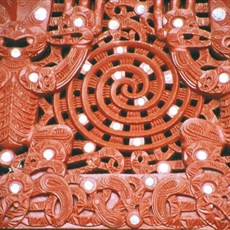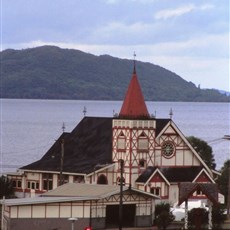2000 Biking New Zealand
Day 20, 27 December 2000, Wednesday
Rotorua; 5km – pottered on luggage-free
bikes, Funky Green Voyager, $39
We slept latish – too divine. And Charl
made our morning coffee as usual despite it being his birthday. Happy 51st,
Charlie.
We planned to visit two thermal areas
today, see St Faith’s and take in a Maori concert, but achieved in the end only
two of these grandiose plans – preferring to sleep the afternoon away, and to
get an early night.
After an abortive hitchhiking attempt, we
taxied to Whakarewarewa (the Maori ‘wh’ is pronounced ‘f’), a Maori-owned/run
thermal region just 2km south of town. Where we took a tour with a young Maori
guide. He told us, inter alia, that a Tahitian King had accompanied Captain
Cook on his trip to New
Zealand in 1769. The king named the resident
Polynesians ‘Maori’ which means ‘common people’. The Maori kept no written
history. Their history and genealogy is recorded and remembered in song and in
the meeting-house carvings of ancestors – the meeting house in effect being a
library, therefore. These carvings are deliberately distorted because the
carver is not the maker and cannot therefore accurately depict ancestors or
humans, for that matter. In fact, attempting ‘perfect’ images is seen as
arrogant – no wonder whites are deemed arrogant! There are 120 Maori tribes in New Zealand,
each with their own dialect, but each dialect understood by all.
Most carved figures have three fingers only
– representing birth, life and death. The penis and vulva, inevitably
oversized, represent fertility; the protrusion of the tongue represents
defiance (such as seen in the All Blacks’ ‘haka’). The haka (a chant) is used
both to scare the enemy and warm the body for battle. Paua shell eyes depict
ancestors watching over one. No shell: a blind ancestor (or stolen by a
Pakeha). The traditional colours are red, white and black, using natural dyes.
The carvings in the meeting / ancestral house are done by men and are
interspersed with flax weaving by women – showing balance. On many of the carvings
are Maori tattoos. Real tattoos were made thus: an incision mallet-tapped into
the skin with a bird-bone blade dipped in a pigment of soot and water .
Our young guide talked about tribal
conflict – the Maori ‘once were warriors’ after all – and Charl asked if tribal
conflict was still alive a la faction fighting in South Africa. Our guide said that
conflict nowadays is verbal. For example, people always remind him that his
tribe lost an important war and had to retreat. But his tribe took the intelligent,
beautiful women with them – of which fact he in turn reminds others. He also
told us that the actions of an individual still reflect very powerfully on his
tribe. And that the traditional Maori greeting actually includes the question:
What tribe do you come from? (And Kia Ora – used by many New Zealanders – means
hello, goodbye, welcome.) Our guide’s tribe is a bush tribe who still live
fairly isolated and in the traditional way (I wondered if they use the national
health service, but didn’t ask). He sounded quite proud of this and a part of
it until a question led him to admit that he does not like bathing in cold
water, prefers to have access to a phone, and favours fast foods over a
slow-cooked hangi (traditional meal steamed underground for three hours)!
Rotorua is built in a dormant volcano.
Below the town’s streets, 1.5km down, is hot magma. So mud pools and geysers
and steam holes abound, and these we visited after our sojourn in the meeting
house. The Puhutu Geyser in Whakarewarewa has been erupting constantly for 186
days now (one in Yellowstone erupted for over
two years). Possibly because the use of hot water for residential purposes is
lowering the water table. Locals are not allowed therefore to drill new holes
for water within a 1.5km radius of the central attractions.
We visited also two kiwis in a darkened
‘house’. These are shy nocturnal monogamous flightless birds, smaller than
chickens, but with eggs three times chicken-size. In fact, the egg virtually
fills the female’s body. Kiwis are like, but smaller than, the ostrich and emu
– more closely related, in fact, to the now-extinct moa. With a long beak,
short legs with three clawed toes, and dense hair-like feathers much favoured
for Maori chief garb in days gone by. Kiwis do have wings, but these measure
only about 5cm and are completely hidden by the feathers. There are three types
of kiwi in New Zealand,
the female being larger than the male. The female lays 1-2 eggs which are
incubated by the male for 75-80 days. During the first World War, New Zealand
troops were known as kiwis; and the Royal Air Force affectionately nick-named
its non-flying members Kiwis. Flightless birds evolved in areas like New Zealand
which originally had no mammals (other than bats), in other words no predators.
So there was no need to fly and no need to limit size and shape.
This pair are kept in separate sections –
with a wall between them – as they will kill each other if they have already
mated in the wild (they were only recently caught in traps and are as yet
unaccustomed to each other). Outside the ‘house’ was a board telling their
story and a request to be quiet upon entering the premises. Charl and I snuck
in on silent feet and stood to one side to give our eyes times to adjust to the
dark. And were disturbed to hear someone talking rather loudly. Turned out to
be an official with an infrared beam she was using to point out first one bird
then t’other. Saying: “Move along, keep moving please, here’s the male, here’s
the female, here’s the rail, move along out please’ – or words to that effect.
Completely ruining the ambience and giving us very little time to view the
birds. In the dark I took the elbow of a man I assumed to be Charl, but who
turned out to be someone else altogether. Who yanked his arm away in a
semi-panic.
One type of Moa apparently stood 3m tall.
All Moa were hunted to extinction by the Maori 1 000 years ago – after which
the Maori changed their diet to fish and sometimes humans.
After our afternoon snooze we shopped for
tomorrow, dropped our goods back at the FGV, and cycled to St Faith’s Anglican
Church situated on the lake’s edge. The church has undergone three incarnations
/ improvements since 1885. The exterior is Tudor; the interior decorated with
Maori carvings and flax panels. There is a superb etching of Christ – in a Maori cloak – on a window overlooking
the lake. Designed to appear as though he is walking on the waters of Lake Rotorua.
(When we later told Dee and Keith about this etching – see Auckland
– Dee said it was a good thing Christ was wearing a cloak otherwise he undoubtedly
would have been depicted with a giant willy!) There used to be a statue of
Queen Victoria
outside the church – a gift to the Maori who supported the British during the
Maori Wars. There are still the graves of war veterans, both Maori and British,
in plain white. And opposite is the Tamatekapua Meeting House which dates from
1887 and which was named after the captain of the Arawa canoe which initiated
the Maori colonisation of New
Zealand.
On our way back to the main drag we cycled
past kids feeding black swans on the lake and a superb Victorian building in a
park. We had drinks in a pub, a long discussion about tomorrow’s route with a
man from whom we bought a map, and emailed home. Then went to Zippy Central –
the restaurant that was closed last night – for an infinitely better meal:
white bait fritters for Charl and fettuccini with smoked chicken and avocado
for me. There is no smoking in the restaurant – from 6pm to 9pm!

Whakarewarewa meeting house

Whakarewarewa meeting house

Whakarewarewa meeting house

Rotarua

Rotarua

Rotarua

St Faith's

St Faith's